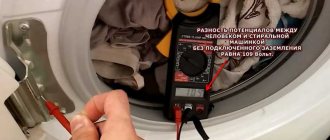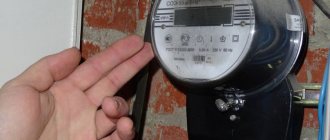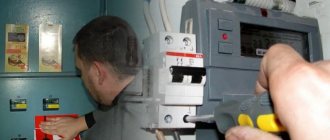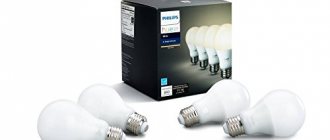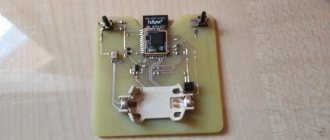If grounding in the apartment , this is fraught with dangerous consequences, including a fairly noticeable electric shock. This situation is typical for old buildings, the residents of which independently eliminate defects during construction. When choosing grounding options, some residents agree and install a protective circuit near the entrance to the entrance.
Others install special devices in the load lines (they are called RCDs) that guarantee the protection of humans and animals from emergency current leaks. And still others take it and, without thinking twice, connect the grounding bus to the contact terminal on the heating battery.
Example of the need for grounding
Grounding a bathtub in an apartment
Grounding the electrical wiring is necessary to prevent shock from capacitive current resulting from voltage leakage through the branch of the LC filter, the middle of which is connected to the body of the device. Such filtering devices are used, for example, in some models of washing machines. When connecting the washing machine to an ungrounded socket, the potential difference between the surface of the device and the person next door will be equal to the input voltage divided by 2. The described case is also fraught with the possibility of false triggering of the RCD.
If you grab zero with one hand and the phase with the other, the body will become a conductor between different potentials
Another example is preventing the consequences of electromagnetic incompatibility of devices connected to the network. If the zero working cable breaks, then all devices connected to the network fail. Grounding is also important to protect electronic computing devices from electrical discharge emanating from the human body. It has low power, but sometimes it is enough for the device to fail or begin to freeze. The grounding system equalizes the potentials, thereby preventing a situation where, when the heating pipe and the computer's operating panel touch simultaneously, the latter begins to malfunction due to an electrical discharge.
What is grounding and why is it needed?
In the vast majority of apartments in the exploited housing stock, power supply is carried out using a two-wire circuit. Two conductors are brought into the apartment from the distribution board - phase and neutral (“zero”). At the same time, almost all modern equipment is equipped with plugs for a three-wire network, which, in addition to those listed, uses a ground wire (“ground”).
For users who are less familiar with the rules for the safe operation of electrical installations, this discrepancy raises many questions. The most common of them:
- Can three-wire plugs be connected to a two-wire network?
- Will the equipment (by the way, quite expensive) work?
- What role does grounding play in general, and why is such a connection provided?
- If grounding is really necessary, is it available in the apartment?
- If there is no ground loop, how to organize it?
In principle, for the operation of most household appliances, a phase voltage supply of 220 (230 in accordance with the current standard) V is sufficient. In order for this or that device to work, it is enough to supply it with power from a normal two-wire network for an apartment.
At the same time, the equipment is guaranteed to demonstrate the indicators (power, productivity, etc.) specified by the manufacturer in the technical documentation (operating instructions).
Hence the simple conclusion: the performance and characteristics of household appliances are not affected by the presence or absence of a ground loop.
The term “grounding” means the forced connection of metal cases and other potentially dangerous (necessarily live, i.e. those through which electric current can flow) parts and elements of electrical equipment with a point guaranteed to have zero potential (“ground”).
This is necessary to ensure user safety during operation of electrical appliances.
A simple example. If all components of the same washing machine are in full working order, its metal body is reliably isolated from the electrical network and does not pose a danger to the owner. However, if there is an insulation breakdown (on heating elements, motors, power conductors), the same housing may become half-voltage (potential).
When the user touches it, it creates a path for electrical current to flow through their body. Everyone knows about the dangers of such a situation - in the worst case scenario, electric shock can have fatal consequences.
To eliminate such situations, grounding is used. In this case, the body of the equipment (the same washing machine) always remains at zero potential, and in the event of the problems described above, a path for current flow is created through the grounding conductor. Since its resistance is many times less than the resistance of the human body, the danger of electric shock is eliminated for the latter.
Existing grounding systems
In the practice of electrical installation work the following are used:
- TN-C is a very popular, but not very reliable system without an additional circuit and protective cable. The functions of the last and working zero are combined in a PEN cable. Input cables are PEN and three phase, output cables are PEN and one phase.
- TN-S differs from the previous one by separating the neutral and protective conductors throughout. Then the number of cables at the input and output is 5 and 3, respectively.
- TN-CS - from the substation to the apartment the conductors are connected, but in the ASU they are separated, and the list of input and output wires is identical to the TN-S system, but implementation will be cheaper.
- TT - voltage passes through zero and three phases, and the grounding wire is separated from the neutral and placed at the input. The scheme is perfect for the private sector.
- IT - electricity flows through three phase cables, and the neutral is separated from the ground, and the reliability of the insulation must be constantly monitored. Suitable for electrical installation.
TT
IT
If in doubt when choosing a system, it is recommended to consult a qualified electrician.
FAQ
Is it possible to organize a grounding loop not for a separate apartment, but for the entire entrance or house?
Of course you can. When calculating grounding, the consumer power parameter is not used, so the calculated circuit allows you to connect all consumers of an apartment building.
When organizing grounding, does the material and cross-section of the PE conductor matter?
It has, since its resistance is taken into account in the total resistance of the system. Therefore, it is recommended to carry out wiring along drains or the wall of the house with copper wire with a cross-section of at least 8-10 sq. mm or a steel busbar with appropriate resistance.
Is it possible to ground devices “in series” by extending the grounding conductor from one to the other?
This connection method is not recommended. The correct options are to connect each device with its own grounding conductor to a common grounding point or organize a common bus with each device connected to it (this is how a three-wire grounded network works).
Should electrodes and grounding strips be painted?
No, otherwise contact with the ground will worsen and resistance will increase significantly.
How to protect welding points on a steel grounding conductor from corrosion?
Welding areas can be coated with bitumen compounds; they will provide reliable protection from the influence of all negative factors.
It is not difficult to make grounding in an apartment on your own. At the same time, you should take care to comply with the requirements of the PUE and not use prohibited methods that will only give the illusion of safety.
How to make grounding in an apartment if there is none
If the house does not have grounding, the tenant should consider options for organizing a grounding system in a high-rise building. The following cases are possible:
- The preferred option is to ground the wiring, observing all the rules of the PUE. You can contact your home electrician to find out what type of system is right for you. If we are talking about grounding in an old apartment building, you need to find out whether they plan to change the outdated system to TN-CS.
- In low-rise buildings (less than 5 floors) for one or several apartments, you can make TT grounding, organize a separate circuit, independent of the source.
Using “quick” options such as installing a protective cable for a separate apartment is strictly prohibited - this is fraught with consequences for the health of the residents.
Tips and tricks
- Electricians recommend grounding all household appliances and sockets in the apartment;
- Electrical appliances cannot be grounded in a chain through each other. This may cause electromagnetic incompatibility and ground loop failure;
- special terminals should be used; twisting at the joints is not allowed;
- Only one wire can be connected to each PE bus terminal.
Grounding will make it safe to use electrical appliances in the apartment. There are several connection systems, the most common is TN-C; it does not have a separate grounding conductor and is outdated. To protect a person from electric shock, you can install an RCD and assemble your own protective circuit. If you follow safety precautions and PUE standards, this will not cause much difficulty.
Stages of self-conduct
The sequence of work is determined by which connection diagram will be used. When modernizing old high-rise buildings, the TN-CS option is used. For him, the algorithm will look like this:
- turn off all traffic jams and automatic machines, turn off the current in the apartment;
- provide a clear view of the wiring, remove plaster;
- remove the sockets and connect wires with stripped ends to their contacts;
- connect the outlet terminals and then de-energize the entire residential building (or riser);
- connect the organized grounding to the common phase one.
After this, you can turn on the power supply in the building and the apartment itself.
Where to get grounding in the floor panel
If grounding is not provided by the construction company, consumers are most interested in how to protect themselves from electric shock. There are two safe ways to solve this problem.
RCD connection
The residual current device cuts off the power to the unit that has a current leak (as well as the corresponding outlet). In addition to this, you can replace the wiring in the apartment with a three-wire one. If grounding work is then carried out at the entrance, the owner will only have to route the PE cable to the required panel bus.
Installation of your own circuit
A copper single-core PE cable of at least 4 mm in diameter is laid to the basement. 3 metal corners are installed near the house. The triangle is connected to the wire, its second end is installed on the shield. Now the apartment grounding must be connected to the panel grounding.
What is not recommended to do
Sometimes apartment owners, in order to save money, try to use “non-standard” options for organizing grounding - for example, a jumper between zero and the protective conductor, screwing in protection only for their apartment, using heating or gas pipes as grounding conductors. Doing this is strictly prohibited.
Local network intervention using “quick fixes” does not protect against emergency situations; moreover, its organizer will not be able to present a material risk due to the lack of an official right to make upgrades to the existing system. Using pipelines as grounding can result in the death of a resident or the destruction of a building.
Before organizing a grounding system, you should consult with the workers servicing the house regarding the preferred system option. Unauthorized actions can cause serious harm to the inhabitants of the apartment.
Solution:
The measures were carried out in accordance with PUE 7th ed., SO 153-34.21.122-2003 “Instructions for the installation of lightning protection of buildings, structures and industrial communications” (hereinafter referred to as SO) and RD 34.21.122-87 “Instructions for the installation of lightning protection of buildings and structures" (hereinafter referred to as RD).
Residential buildings are classified as ordinary in terms of lightning protection in accordance with the CO and category 3 in accordance with the RD. The required system reliability is 0.9. According to PUE-7, clause 1.7.103. The total resistance to spreading of grounding conductors (including natural ones) of all repeated groundings of the PEN conductor of each overhead line at any time of the year should be no more than 10 Ohms at a line voltage of 380 V three-phase current source or 220 V single-phase current source.
Lightning protection of the facility was carried out by organizing a lightning protection grid on the roof of the building with the installation of lightning rods to protect the shafts with installed equipment rising above the roof level. The cell size of the lightning protection mesh is no more than 10x10 m. The rolled mesh type is copper-coated steel with a diameter of 8 mm, coating thickness 70 microns (GL-11149). Installation of the mesh is carried out on flat surfaces using the GL-11711 clamp, on vertical surfaces - GL-11703A. The installation step of the clamps is 0.8-1.0 m. To connect the rolled products along the length and at the mesh nodes, a universal clamp GL-11551A is used. Lightning protection masts are installed on a vertical surface using GL-21201 holders. All metal elements placed on the roof (ventilation shafts, stairs, fencing, etc.) must be connected to the lightning protection mesh using GL-11545A clamps. Copper-plated steel with a diameter of 8 mm (GL-11149) is used as current leads. The step for connecting the grid to the down conductors is no more than 25 m. Every 20 m (building height) install a horizontal electrode (GL-11149) around the perimeter of the building. The grounding device is made in the form of a circuit around the perimeter of the building. The horizontal conductor is a copper-plated steel strip 30x4 mm (GL-11075). Copper-plated steel electrodes D=14 mm, L=3 m are used as vertical electrodes. Vertical electrodes are installed in places where down conductors are lowered. The distance from the foundation of the building is at least 1 m.
The results of the calculation carried out using software developed by JSC Energy Institute named after. G.M. Krzhizhanovsky" (JSC "ENIN"):
- density of lightning discharges into the ground - 6 beats/sq.km per year;
- the total number of impacts to the system is 0.0066 (once every 910 years);
- the total number of breakthroughs (strikes directly into an object bypassing lightning rods) - 0.00051 (once every 1810 years);
- protection reliability: 0.923.
Calculation of the resistance of the grounding device:
Vertical electrode resistance:
where ρeq – equivalent soil resistivity, Ohm m; L – length of vertical electrode, m; d – diameter of the vertical electrode, m; T – depth – distance from the earth’s surface to the ground electrode, m;
Horizontal electrode resistance:
where ρ – soil resistivity, Ohm m; b—width of the horizontal electrode strip, m; h is the depth of the horizontal grid, m; Lhor – length of the horizontal electrode, m.
where t is the depth of the top of the electrode, m
Grounding device impedance:
where n is the number of sets; kisp – utilization factor;
The calculated resistance of the grounding device is 0.74 ohms, which is less than the permissible resistance of 10 ohms.
List of required materials:
| No. | Rice | vendor code | Product | Qty | Weight (kg per unit) |
| 1 | GL-21103G | GALMAR Vertical lightning rod (lightning rod-mast) (4 meters) | 25 | 10 | |
| 2 | GL-21202 | GALMAR Holder for lightning rod - masts GL-21101G/ GL-21102G/ GL-21103G to the chimney (stainless steel) | 25 | 7,4 | |
| 3 | GL-20022 | GALMAR Clamp for lightning rod - mast GL-21101G for down conductors (stainless steel) | 25 | 0,2 | |
| 4 | GL-11149-10/20/50 | GALMAR Copper-coated wire (D 8 mm / S 50 mm²; coil 10/20/50 meters) | 3500 (in meters) | 0,41 | |
| 5 | GL-11711 | GALMAR Flat roof clamp for down conductor (plastic, concrete) | 3000 | 1,00 | |
| 6 | GL-11551A | GALMAR Clamp for connecting down conductors (painted galvanized steel) | 700 | 0,09 | |
| 7 | GL-11703A | GALMAR Clamp to the facade for a down conductor with its elevation above the clamp by 15 mm (painted galvanized steel) | 400 | 0,02 | |
| 8 | GL-11545A | GALMAR Gutter clamp for down conductor (painted galvanized steel) | 500 | 0,11 | |
| 9 | GL-11563A | GALMAR Control clamp for connecting down conductors wire + wire (painted galvanized steel) | 60 | 0,13 | |
| 10 | ZZ-001-065 | ZANDZ Copper-plated threaded grounding pin (D14; 1.5 m) | 74 | 1,9 | |
| 11 | ZZ-002-061 | ZANDZ Threaded coupling | 38 | 0,082 | |
| 12 | ZZ-003-061 | ZANDZ Starter tip | 37 | 0,074 | |
| 13 | ZZ-004-060 | ZANDZ Guide head for jackhammer attachment | 15 | 0,088 | |
| 14 | ZZ-005-064 | ZANDZ Clamp for connecting conductor (up to 40 mm) | 48 | 0,312 | |
| 15 | ZZ-006-000 | ZANDZ Conductive lubricant | 4 | 0,152 | |
| 16 | ZZ-007-030 | ZANDZ Waterproofing tape | 10 | 0,442 | |
| 17 | GL-11075-10/20/50 | GALMAR Copper-plated strip (30*4 mm / S 120 mm²; coil 10/20/50 meters) | 600 (in meters) | 0,98 |
